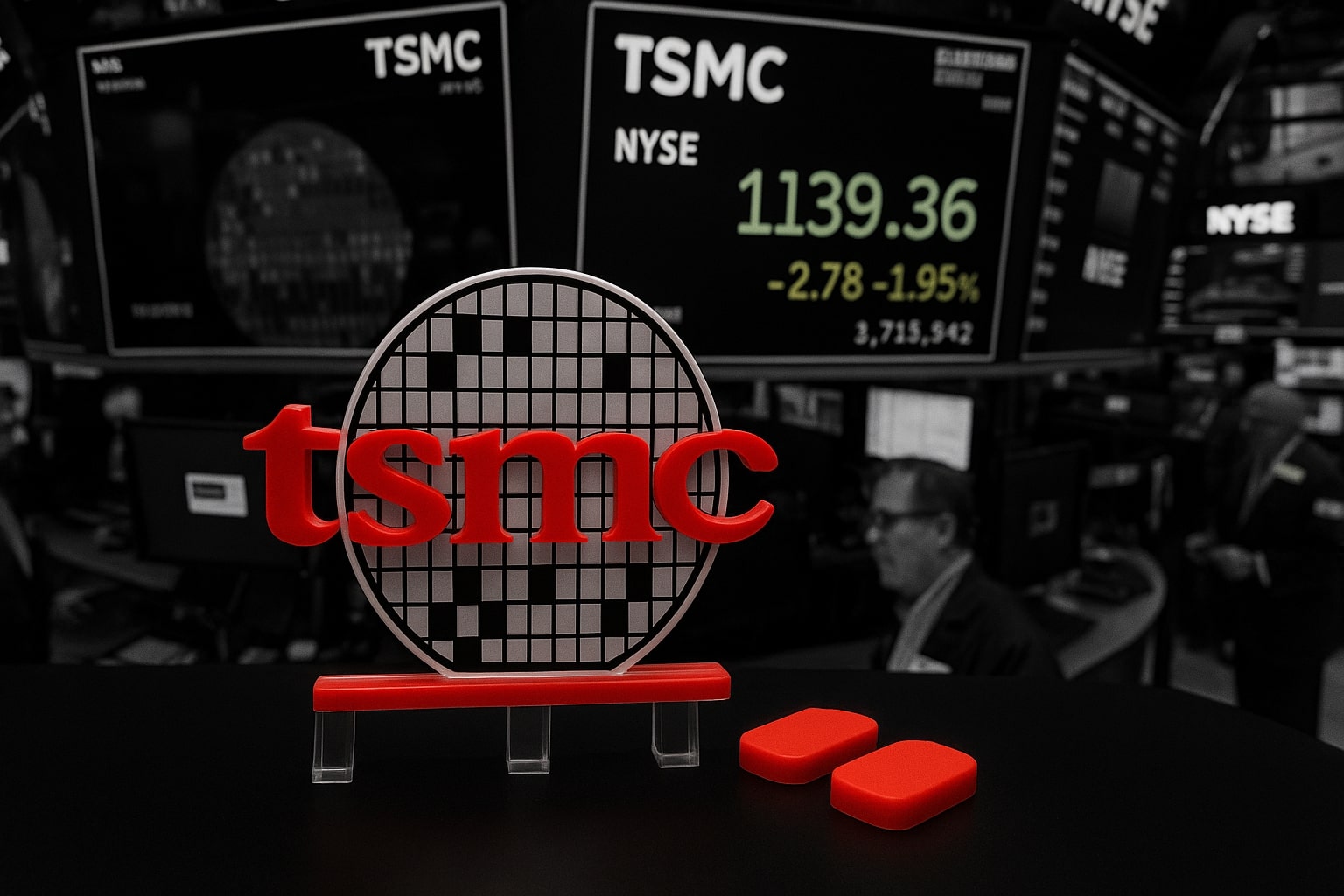
TSMC Stock Price Forecast - (NYSE:TSM) Rallies 74% YTD as AI Chip Boom Lifts Revenue and Margins to Record Highs
TSMC at $185 remains the backbone of AI semiconductor manufacturing, posting $20.8B quarterly revenue and 52.5% gross margin as U.S. and Japan expansions secure long-term growth | That's TradingNEWS
TSMC (NYSE:TSM) Trades Near $185 as AI Demand and U.S. Expansion Redefine Global Chip Power
Taiwan Semiconductor Manufacturing Company (TSMC) continues to dominate the global chip landscape, with its stock climbing to $185.20, up more than 74% year-to-date, as investors rotate heavily toward AI infrastructure names. The company’s market capitalization now exceeds $930 billion, placing it among the world’s top-ten listed firms and solidifying its position as the single most critical manufacturing engine behind the semiconductor revolution. Demand from NVIDIA (NASDAQ:NVDA), Apple (NASDAQ:AAPL), and Advanced Micro Devices (NASDAQ:AMD) has pushed TSMC’s utilization rates back above 95% for advanced nodes, even as legacy chip orders soften.
AI and High-Performance Computing Fuel Record Capacity
TSMC’s advanced 3-nanometer (N3) and 5-nanometer (N5) processes remain the global benchmark. The company reported $20.8 billion in Q2 2025 revenue, a 34% jump year-over-year, with AI-related wafers accounting for nearly 28% of total sales. Its high-performance computing (HPC) division surged 40% YoY, reflecting rising orders for data-center GPUs and custom silicon for AI inference and training.
CEO C.C. Wei emphasized that “AI demand has become a structural growth driver, not a cyclical event.” At current trajectory, the company expects AI-linked revenue to exceed $40 billion annually by 2026, making TSMC’s foundry output more valuable than the entire GDP of some developing economies.
U.S. and Japan Expansion Bolster Strategic Security
To mitigate geopolitical risk and satisfy clients’ diversification demands, TSMC is executing an ambitious overseas manufacturing plan. The Arizona Fab 21 and Fab 22 complexes, scheduled for 2026 mass production, represent a combined $65 billion CapEx investment, partially subsidized by the U.S. CHIPS and Science Act. Once complete, the Arizona site will produce 2 nm and 3 nm chips, the first of their kind on American soil, ensuring that NVIDIA, Apple, and AMD have domestic supply assurance.
In Japan, TSMC’s Kumamoto plant (a joint venture with Sony and Denso) is ramping 22 and 28 nm production, while a second Kumamoto facility announced for 2026 will handle 6 nm nodes, aligning with the country’s automotive and sensor industries. These cross-regional fabs collectively reduce concentration risk from Taiwan to under 60% of total output by 2027, compared with 91% today.
Financial Strength: Margins Recover to 52.5% Gross and 42.1% Operating
After a brief margin dip during the 2023 downcycle, TSMC’s profitability rebounded sharply. Q2 net income reached NT$248.5 billion (≈ US $7.6 billion), up 36% year-over-year, while EPS climbed to NT$9.59. Gross margin expanded to 52.5% from 48.6%, reflecting richer AI mix and yield improvement on 3 nm nodes.
Operating cash flow totaled NT$365 billion (≈ US $11.2 billion), funding an annual dividend increase to NT$3.50 per share quarterly, or roughly a 1.9% yield. Free cash flow margin stands above 32%, well ahead of Intel and Samsung Foundry. TSMC ended Q2 with NT$1.47 trillion in cash (≈ US $45 billion), giving it one of the strongest balance sheets in global manufacturing.
Valuation: Premium Justified by Technological Moat
At ~24.3× forward earnings and 9.8× price-to-book, TSMC trades at a premium to historical averages but below NVIDIA’s multiple of ~32× and well beneath ASML (NASDAQ:ASML). Analysts expect 2025 revenue to reach US $87–89 billion, up ~25%, with EPS surpassing US $8.20. Consensus targets cluster around US $200–205, implying upside of ~10%. Given its technological lead in EUV lithography and 3 nm yield advantage (> 90%), valuation remains reasonable for long-term holders seeking exposure to AI semiconductor expansion.
Geopolitical Risk: Taiwan Strait Tensions vs. Global Diversification
TSMC remains the largest single point of risk in the global tech supply chain. Roughly 60% of its fabrication capacity sits within 100 miles of the Chinese coast, and any escalation in cross-strait relations would carry systemic implications for global markets. However, TSMC’s multi-country strategy is gradually reducing that exposure. By 2028, non-Taiwan output could represent nearly 40% of total capacity.
The U.S. and Japanese governments have positioned TSMC as a strategic asset, making direct military risk less likely given the mutual dependency of Western supply chains on TSMC’s production. Still, investors factor a 2–3% geopolitical discount into TSMC’s valuation versus purely U.S.-based peers.
Read More
-
Meta Stock Price Forecast - META Shares Eyes $875 as AI Expansion and Cash Flow Surge
03.12.2025 · TradingNEWS ArchiveStocks
-
XRP Price Forecast - XRP-USD Hits $2.17 as $756M XRP ETF Inflows And Singapore Approval Ignite Global Demand
03.12.2025 · TradingNEWS ArchiveCrypto
-
Oil Price Forecast - Oil Prices Firm: WTI at $59.20, Brent at $62.91 as Supply Tightens and Russia Talks Stall
03.12.2025 · TradingNEWS ArchiveCommodities
-
Stock Market Today - Wall Street Steadies: S&P 500 at 6,831, Nasdaq 23,383 as MSFT, NVDA, AAPL, MRVL React to Fed Cut Hopes
03.12.2025 · TradingNEWS ArchiveMarkets
-
GBP/USD Price Forecast - Pound Advances to 1.3240 as Dollar Slips on Fed-Cut Speculation
03.12.2025 · TradingNEWS ArchiveForex
AI Ecosystem Momentum: NVIDIA and Apple Deepen Dependence
Roughly 22% of NVIDIA’s foundry spend and 100% of Apple’s A-series and M-series processors flow through TSMC. With the 2025 launch of NVIDIA’s Blackwell and Apple’s A19 Pro chips, TSMC’s 3 nm capacity is fully booked through mid-2026. Each incremental EUV layer adds roughly 5 percentage points to gross margin, making node advancement a direct profit driver. TSMC projects capital expenditure of US $32–36 billion in 2025, with 70% allocated to advanced technology nodes and AI infrastructure.
Technological Leadership and Innovation Pipeline
Beyond 3 nm, TSMC is already ramping R&D for its 2 nm (N2) node with Gate-All-Around transistor architecture. Mass production is expected by late 2026 in Taiwan and the U.S. Simultaneously, the company is developing the A16 node using Backside Power Delivery Network (BSPDN) for 2027 commercialization — a technology expected to cut power consumption by 15% and boost performance by 10–15%. These advances cement TSMC’s edge over Intel and Samsung, both of which trail in EUV throughput and yield consistency.
Insider and Institutional Activity
Institutional ownership remains above 78%, with major holders including Vanguard, BlackRock, and Fidelity. According to recent filings on TradingNews.com/Stocks/TSM/stock_profile/insider_transactions, TSMC executives have kept insider sales minimal since March 2025, reflecting management confidence in mid-term growth prospects. Meanwhile, foreign capital flows into Taipei-listed TSMC shares surged US $5.3 billion in Q3, marking the strongest quarterly inflow since 2021.
Technical Picture: Support at $178, Resistance at $192
From a technical standpoint, TSM has formed a strong ascending channel since February. The stock finds support around $178.40 (50-day SMA) and resistance near $192.10 (2025 high). RSI at 59 suggests room for continuation before overbought conditions appear. A break above $192 could open the path to $200–205, while failure to hold $178 may trigger a pullback toward $165 where long-term buyers typically re-enter. You can track its intraday action at TradingNews.com/Stocks/TSM/real_time_chart.
Verdict: TSMC – BUY for Long-Term AI Exposure and EUV Leadership
TSMC stands as the irreplaceable core of the AI hardware supply chain, combining technological dominance, financial resilience, and geographical diversification. While geopolitical risks remain, the company’s execution on overseas capacity and unmatched EUV capabilities support a robust valuation. At current levels around $185, TSM is a BUY, with a 12-month target range of $200–210, representing upside of ~13%. The stock offers a rare blend of growth visibility and defensive cash-flow strength in the volatile AI semiconductor cycle.


















